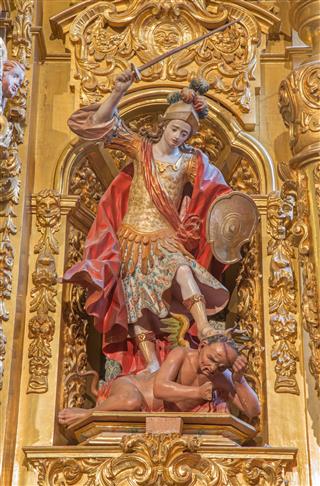
The encomienda system played a major role in helping Spain expand its colonies in the New World. In spite of this, why was it a failure, and abolished in 1542? Historyplex tells you the significance of the encomienda system, along with its purpose, effects, and facts.
Did You Know?
Despite being used in the Spanish colonies for more than 200 years, the encomienda system was never fully supported by its monarchy.
The Spanish conquest of the Americas began towards the end of the 15th century. By this time, the once-sprawling Inca Empire was already in its death throes. However, it was only in 1572 that the Spanish were able to defeat the Incas decisively, and claim the riches of the New World for themselves.
The natives were now left to the mercy of their conquerors, who regarded them as heathens, but saw no harm in using native labor for agriculture, mining, and construction of public projects. Over time, the native population all over colonized America would face an enormous decline; by the 17th century, that of Mexico alone would have decreased by about 90%.
One of the biggest threats faced by the natives, along with the firearms that settlers brought with them, were diseases like cowpox and measles, against which they had no protection. Such epidemics ravaged the native populations; the settlers were protected by medicines they had brought with them. However, another reason for this drastic decline was the horrible conditions that the natives were forced to toil in, owing to the encomienda system of the Spaniards. Here is more about the significance of the encomienda system.
What Was the Encomienda System?
The encomienda system was a method by which the Spanish crown rewarded colonial settlers by entrusting them with a group of natives whom they would civilize and convert to Christianity, in return for gifts in the form of labor, taxes, or goods as tribute. The term ‘encomienda’ is derived from the Spanish word encomendar, which means ‘to entrust’.
Formation
The encomienda system traces its roots to the ‘Reconquista’ or reconquest of Spain, from its Moorish invaders. The Spanish had been fighting to retake their land for 800 years, and when they succeeded in this mission, they established the encomienda system to organize labor and taxation from the conquered Muslim and Jewish occupants.
Towards the end of the 15th century, when Christopher Columbus conquered the West Indies, he was the first one to grant encomiendas to his subordinate officials and soldiers as rewards for their contribution to the crown, and also to reduce the chances of revolt. Later, as Spain successfully conquered parts of North, Central, and South America, and the Philippines, this system was set up in these colonies as well.
The difference between the Spanish and American encomiendas was that, in the former, the land was owned by the grantees, while in the New World, the right to the land was to remain with the natives. This system was not new to the Americas; a similar arrangement existed during the Inca and pre-Inca civilizations.
Characteristics
In this arrangement, a grant was conferred by the monarch to soldiers, officials, and other Spaniards who had played a major role in a conquest, giving each a control over all natives that lived in a specific region. These officials were called ‘encomenderos’, and had to ensure that the Indians under their control were trained in Spanish culture, educated in Christian beliefs, and protected from other warring tribes of the region. In return, the natives were to provide labor, pay taxes, or tributes like gold, silver, foodstuff, crops, chickens, or captured game to the grantees. In addition, the encomenderos were also required to pay a tax to the crown. This grant came with restrictions, like the crown could transfer the encomenderos to other regions, and the grant was valid only for two successive generations of the grantee’s family.
Intended Purpose
The conversion of the natives to Christianity had always been a driving force behind the invasions, along with the desire for riches. The Spanish monarchy believed that once an Indian accepted the authority of the Spanish crown, and the Roman Catholic faith, he should be treated as a subject of the crown and deserved their protection. When the settlers first arrived, they were reluctant to work, so native labor was desirable. Since they had braved the long voyage from Spain, and the risk of death in war, the settlers believed that they deserved a reward. So, the monarchy established the encomienda system to keep them happy, so that they wouldn’t revolt. The Spaniards also wanted to avoid outright slavery, against which there was an ideological bias at the time.
Effects
The arrangement had a fairly good beginning; the natives learned Spanish, provided labor for wages, and were educated in the Christian faith on Sundays. However, the negative effects of granting encomiendas to conquistadors, whose sole interest lay in obtaining wealth, was soon apparent. Since the encomenderos had to be ready for resettlement orders at all times, they made the natives slog in inhuman conditions, wishing to make large profits in less time. They openly defied the restriction on land ownership, and grabbed land and livestock from the natives at an unfair compensation.
Most of the encomenderos did not visit the natives under their protection, but rather kept middlemen who were corrupt, and sought their own share from the Indians. The friars who were in charge of evangelizing the natives also demanded foodstuff and other goods in return. This added to the economic misery of the Indians. Since the encomenderos did not live among the local populations, the latter were forced to travel long distances carrying heavy goods as tributes. Besides, the rate of taxation was not changed, even at times of crop failure, making work necessary for paying taxes, as well as to obtain money for food.
The extreme conditions under which the natives had to work, especially in mercury mines, took a toll in the hundreds of thousands. In fact, the encomienda system decimated large sections of the native population, a tragedy first reported from West Indies under Columbus.
The encomenderos, being little more than ruthless conquerors, dealt with the natives with a heavy hand. In one instance, when one official from Santiago heard rumors that a nearby Cacique tribe was planning a rebellion with 15,000 men, he promptly tracked them down and had almost all of them hanged. Natives who attempted to escape from their dismal slavery also received a similar fate.
However, some historians point at a few good effects that the encomienda system had in its initial years, like protecting the natives when war, disease, and famine ravaged large sections of the Americas. It is also credited with preventing an outright revolt by the natives against their colonial masters.
Abolition
The first protests that went up against the encomienda system were raised as early as 1510, by preachers who had witnessed the atrocities of the encomenderos. Strange as it may seem, the monarchy had never fully backed this practice, and at times even openly showed its hostility to the encomenderos.
However, the most prominent protest was raised by Bartolomé de las Casas, a priest and former encomendero, who petitioned the Spanish King to abolish this practice, and even feared that it would even bring about the total decimation of natives.
This resulted in the Law of Burgos of 1512, which abolished mistreatment of the natives, and later, the New Laws of 1542, which gave the status of free men to the natives, and started the process of banning the encomienda system.
However, when the Viceroy of Peru, Blasco Nunez Vela tried to enforce these laws, he was killed by the encomenderos. This led the Spanish crown to postpone the abolition of the system, fearing the loss of their colonies. As a result, it continued unabated till the year 1717, when the monarchy finally abolished the system by a royal decree. However, the system went on in remote parts of the New World, like Mexico, where it was ultimately banned after a revolution in 1911.
Facts About the Encomienda System
The encomienda system began in the early 16th century, and continued till the beginning of the 18th century in most parts of the New World.
The prime motivation for this system was to bring Christianity to the ‘heathens’, as the natives were called by the colonial settlers. The Roman Catholic Church had allowed newly conquered territories to be annexed by Spain, only if the natives were converted. This rule was mentioned in the papal bull ‘Inter Caetera’ published in 1493.
While it was established to avoid slavery, the system was exploited by the colonial elite for their greed, to make it one of the harshest labor systems in the New World.
From converting the natives’ beliefs, the goal eventually changed to obtaining revenue for the grantees. With time, the goal of evangelizing was dropped altogether, as it did not serve the encomenderos’ interests.
This system enabled Spain to conquer more territories in the New World, as it allowed them to extract labor from the natives.
Spanish laws forbade mestizos (interracial natives) to be summoned for labor. So, to escape their dismal working conditions, many Indians sought marriages with white people, and people of other races like the Creoles.
The harsh treatment meted to the natives depleted their population in some areas to such an extent, that the Spaniards were forced to seek African slaves from other colonial powers, like the French and Portuguese, under an arrangement called the Asiento system.
The encomenderos and their descendants in Spanish colonies were lobbying for the encomienda system to be granted permanent status under Spanish law. This was because, they were totally dependent on the exploitation of the natives for their wealth and power, and the passing of the New Laws in 1542 made this impossible, making them take up arms against the crown.
The Spanish crown began making arrangements to slowly phase out the system from the mid-16th century, by replacing them with the repartimiento and hacienda systems, in which natives were given the rights of free men, and were directly employed by estate owners to produce crops for small-scale markets. However, these systems were again exploited to enslave the natives of Peru, in the 16th century.
While most of the encomenderos were white men, comprising conquistadors and soldiers, in a few rare cases, encomiendas were granted to women and native chieftains as well. Examples include the grants offered to Aztec ruler Moctezuma’s daughters by the conquistador Hernán Cortes.
The encomienda system highlights the dangers of colonialism, where a system designed to protect natives from forced labor ends up being exploited to do exactly that, and officials become so dependent on exploitation that they are prepared to take up arms against anyone who challenges their interests, even their own monarch.










